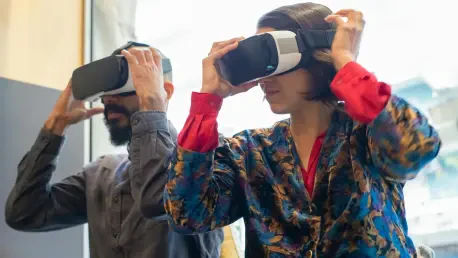The metaverse has evolved from a distant concept into a tangible force reshaping how people interact with technology, and Meta Connect 2025 has proven to be a pivotal moment in this transformation, unveiling a host of innovations. Hosted by Meta, this annual gathering showcased a slew of advancements that are pushing immersive digital experiences closer to everyday reality. From cutting-edge wearables to intelligent ecosystems, the conference highlighted developments that promise to redefine personal and professional landscapes. Whether one is deeply invested in tech or simply curious about the digital future, the innovations presented this year offer a compelling glimpse into a world where virtual and physical boundaries blur. This exploration delves into the standout trends that emerged, painting a picture of a metaverse that is no longer just an idea but a growing part of daily life. The focus spans hardware breakthroughs, software ecosystems, and real-world applications, each contributing to a broader vision of connectivity and interaction.
Wearable Tech Paving the Way for Immersion
Meta’s emphasis on wearable technology marks a significant step toward making the metaverse accessible to all, with smart glasses emerging as a key entry point. Devices like the Ray-Ban Meta and the recently introduced Oakley Meta HSTN glasses, retailing at $499, showcase a blend of fashion and functionality with integrated AI capabilities. These products target a wide audience, from casual users to professionals on the go, by offering hands-free access to digital tools. Beyond aesthetics, they represent a shift in perception—wearables are no longer niche gadgets but practical solutions for modern needs. Speculation around the Hypernova (or “Celeste”) glasses, potentially priced at $800, adds to the excitement with whispers of in-lens displays for real-time data and neural wristbands for gesture control. Such innovations hint at a future where technology seamlessly integrates into daily routines, bridging the gap between digital and physical worlds with unprecedented ease.
This push toward wearable integration isn’t just about novelty; it’s about redefining how technology fits into human lives. The rumored Hypernova glasses, if realized, could transform mundane tasks like checking notifications or navigating directions by embedding information directly into one’s field of vision. Meanwhile, the neural wristband concept, which interprets subtle muscle movements for control, suggests a leap beyond traditional inputs, making interaction more intuitive. These developments cater to diverse demographics—gamers seeking immersive experiences, commuters needing quick updates, or workers requiring hands-free tools. While some details remain unconfirmed, Meta’s direction is clear: wearables are set to become as commonplace as smartphones, acting as personal gateways to a broader digital realm. The challenge lies in balancing innovation with practicality, ensuring these devices are comfortable and affordable enough for widespread adoption.
AI Powering a Smarter Digital Experience
Artificial intelligence stands at the core of Meta’s strategy, transforming the metaverse from a static virtual space into a dynamic, responsive environment. In current offerings like the Ray-Ban Meta and Oakley Meta glasses, AI facilitates voice-driven commands, real-time language translation, and contextual support, making interactions effortless. This technology isn’t merely an add-on but a foundational element that personalizes user experiences, adapting to individual preferences and needs. The potential of the speculated Hypernova glasses to display AI-generated prompts directly in the lens points to an even deeper integration, where digital assistance becomes visually immediate. This approach reimagines the metaverse as a proactive companion rather than a passive platform, fundamentally altering how users engage with both information and each other in virtual spaces.
Beyond enhancing user interfaces, AI’s role extends to creating richer, more meaningful connections within the metaverse. By anticipating user actions and offering tailored suggestions, it ensures that digital interactions feel natural and relevant, whether one is exploring a virtual world or managing daily tasks. The seamless fusion of AI with spatial computing, as hinted at in upcoming devices, could redefine productivity and entertainment by eliminating friction between intent and action. For instance, real-time translations could break down language barriers in global virtual meetings, while contextual cues might enhance gaming or learning environments. However, the success of this integration hinges on refining accuracy and ensuring privacy, as users will demand transparency in how their data fuels these intelligent systems. Meta’s focus on AI signals a future where the metaverse isn’t just visited but lived in, with technology that truly understands its users.
Interaction Innovations Breaking New Ground
The way humans interact with digital environments is undergoing a radical transformation, with Meta introducing concepts that could render traditional controls obsolete. A standout innovation is the neural wristband, leveraging surface electromyography (sEMG) to detect minute muscle movements and translate them into commands. This technology eliminates the need for bulky controllers or even voice inputs, offering a fluid, almost invisible method of engagement. Such advancements hold immense promise not only for convenience but also for inclusivity, enabling individuals with physical limitations to navigate the metaverse with greater ease. This shift toward natural interaction methods underscores a broader goal: to make technology an extension of human instinct rather than a separate tool requiring conscious effort.
This focus on intuitive control mechanisms also reflects a deeper understanding of user needs within immersive spaces. By reducing the learning curve and physical barriers associated with digital interaction, Meta aims to make the metaverse accessible to a broader audience, from tech-savvy youth to older generations. The potential applications are vast—imagine controlling a virtual workspace with subtle gestures or navigating a game environment without lifting a finger. Yet, challenges remain in perfecting this technology to ensure reliability and precision across diverse user scenarios. Additionally, public acceptance of such intimate interfaces, which monitor bodily signals, will depend on robust safeguards for data security. Nevertheless, these innovations mark a critical step toward a metaverse that feels less like a constructed space and more like a natural part of human experience.
Ecosystem Growth Through Horizon Platforms
Meta’s vision extends beyond hardware to encompass a robust digital ecosystem, with platforms like Horizon Worlds and Horizon OS serving as the backbone of social and creative interaction. These environments are evolving to prioritize mixed reality experiences, fostering deeper connections among users through shared virtual spaces. The integration of AI-generated content, such as dynamic worlds or interactive non-player characters, hints at a future where digital landscapes are endlessly customizable and responsive. This isn’t merely about gaming or escapism; it’s about building a cohesive network where hardware and software synchronize to create lasting engagement. The ambition is to move past fragmented experiences and establish a metaverse that feels interconnected and purposeful.
Developing such an ecosystem requires addressing the demand for compelling content that keeps users returning. Horizon platforms are being positioned as hubs for creativity, collaboration, and exploration, where individuals can design their own spaces or join others in shared endeavors. This focus on user-generated and AI-enhanced content could redefine entertainment and social interaction, making virtual gatherings as meaningful as physical ones. However, the success of these platforms depends on striking a balance between accessibility and depth—ensuring they are easy to navigate while offering rich, diverse experiences. Competition from other digital spaces adds pressure to deliver unique value, pushing Meta to innovate continuously. If executed well, this ecosystem could become the foundation of a metaverse that transcends novelty, embedding itself into how people connect and express themselves daily.
Enterprise Solutions Fueling Mainstream Impact
While consumer-facing innovations often dominate attention, Meta’s strides in enterprise applications reveal a powerful catalyst for metaverse adoption. Industries such as healthcare, education, and manufacturing are beginning to harness smart glasses and augmented reality tools for practical purposes, like hands-free data access during surgeries or virtual training simulations for technicians. These use cases demonstrate tangible benefits, from improved efficiency to reduced operational costs, making a strong case for investment in immersive tech. By addressing real-world challenges with digital solutions, Meta is positioning the metaverse as a critical asset for businesses, potentially accelerating its integration into mainstream markets well before consumer saturation.
The scope of enterprise applications extends to reshaping how teams collaborate across distances, with AR overlays guiding complex tasks or virtual environments hosting interactive learning sessions. For example, students can conduct experiments in simulated labs, while engineers troubleshoot machinery with real-time digital assistance. These scenarios highlight the metaverse’s potential to bridge gaps in expertise and resources, offering scalable solutions to global industries. Yet, adoption isn’t without hurdles—issues of reliability, data security, and compliance with regulatory standards must be resolved to build trust among corporate users. If these challenges are met, enterprise success could create a ripple effect, normalizing metaverse technologies in professional settings and paving the way for broader societal acceptance over the coming years.
Overcoming Barriers on the Path Forward
Despite the excitement surrounding Meta’s advancements, significant challenges persist in turning ambitious concepts into flawless realities. Speculation about the Hypernova glasses suggests limitations, such as a narrow field of view, which falls short of the fully immersive augmented reality many envision. Practical concerns like battery life, ergonomic design, and affordability also loom large, potentially hindering mass appeal. On the software side, platforms like Horizon Worlds must continuously deliver fresh, engaging content to retain user interest, while enterprise tools face scrutiny over security and dependability. These obstacles underscore the gap between visionary ideas and their real-world execution, reminding stakeholders that innovation requires patience and iterative improvement.
Addressing these barriers will be crucial for sustaining momentum in the metaverse’s growth trajectory. Technical limitations in hardware demand focused research to enhance immersion and usability without compromising comfort or cost. Simultaneously, software ecosystems need strategic content development to avoid user fatigue, ensuring virtual spaces remain vibrant and relevant. For enterprise applications, building robust frameworks for data protection and system stability will be non-negotiable to gain institutional confidence. While Meta has laid a strong foundation, navigating these hurdles will determine whether the metaverse remains a promising concept or becomes an indispensable part of global infrastructure. The path forward involves not just innovation but also a commitment to solving the practical pain points that could stall progress.
Reflecting on a Digital Turning Point
Looking back at the revelations from Meta Connect, it is evident that the metaverse has taken significant strides toward becoming an integral facet of modern existence. Smart wearables like the Ray-Ban Meta and rumored Hypernova glasses showcased how technology could blend into daily routines, while AI emerged as a vital force in personalizing digital interactions. Innovations in human-computer interfaces, such as neural wristbands, hinted at a future of effortless control, and platforms like Horizon Worlds laid the groundwork for interconnected virtual communities. Enterprise applications, meanwhile, demonstrated concrete value, potentially driving broader acceptance. Despite persistent challenges, the event marked a defining moment, highlighting a trajectory where digital and physical realms increasingly converge. As these trends continue to unfold, staying informed about evolving solutions and contributing to discussions on accessibility and security will be essential for shaping a metaverse that benefits all.









